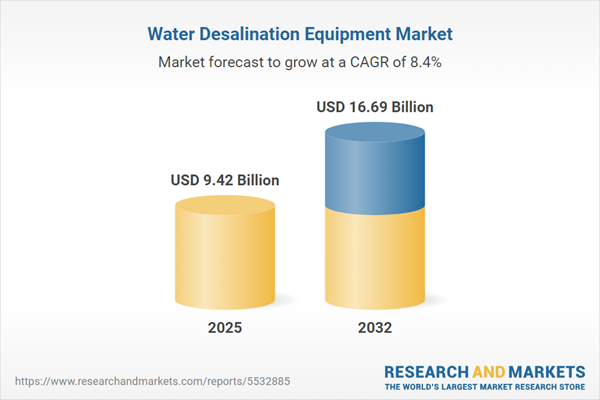Speak directly to the analyst to clarify any post sales queries you may have.
The water desalination equipment market is becoming pivotal for senior decision-makers committed to ensuring resilient access to sustainable freshwater amid evolving global scarcity and regulatory complexities. With rapid innovations and shifting trade dynamics, understanding the landscape of desalination solutions is mission-critical for organizations navigating today’s resource challenges.
Market Snapshot: Water Desalination Equipment Market Growth and Outlook
The water desalination equipment market grew from USD 8.73 billion in 2024 to USD 9.42 billion in 2025. It is projected to sustain a compounded annual growth rate (CAGR) of 8.43%, reaching USD 16.69 billion by 2032. Key drivers include escalating global water scarcity, advancements in desalination technology, and increased demand for sustainable water sources from municipalities, industries, and commercial users worldwide.
Scope & Segmentation
This report gives an in-depth assessment of critical trends, strategic opportunities, and competitive dynamics across global water desalination equipment markets. Analysis spans technology developments, supply and demand factors, regulatory trends, and key industrial use cases.
- Technology Type: Electrodialysis, Reverse Osmosis, Solar Desalination
- Energy Source: Fossil Fuels, Natural Gas, Geothermal Energy, Solar Energy, Wind Energy
- Installation Type: Fixed Desalination, Portable Desalination units
- Water Source: Brackish Water, River Water, Seawater, Wastewater
- Application: Commercial sectors; Industrial including Mining, Oil & Gas, Paper & Pulp, Power Generation; Municipal
- Geography: Americas (United States, Canada, Mexico, Brazil, Argentina, Chile, Colombia, Peru), Europe (United Kingdom, Germany, France, Russia, Italy, Spain, Netherlands, Sweden, Poland, Switzerland), Middle East (United Arab Emirates, Saudi Arabia, Qatar, Turkey, Israel), Africa (South Africa, Nigeria, Egypt, Kenya), Asia-Pacific (China, India, Japan, Australia, South Korea, Indonesia, Thailand, Malaysia, Singapore, Taiwan)
- Key Companies Profiled: Veolia Water Technologies, SUEZ SA, Doosan Corporation, DuPont de Nemours, Inc., IDE Water Technologies, Alfa Laval Corporate AB, Mitsubishi Heavy Industries, Ltd., and others
Key Takeaways for Decision-Makers
- Emerging membrane innovations and integration of renewable energy are transforming efficiency and operational standards for desalination projects.
- Regulatory expectations are intensifying, with environmental stewardship and resource conservation increasingly prioritized in procurement and operational strategies.
- Digitalization empowers real-time asset management and predictive maintenance, enabling enhanced reliability and reduced operational downtime.
- Regional partnerships and collaborations are crucial for addressing local water challenges and fulfilling diverse application requirements.
- Leading industry players are adopting outcome-based service agreements to deliver measurable performance and value, aligning with evolving client needs.
Tariff Impact: Navigating U.S. 2025 Tariff Adjustments
The 2025 introduction of new U.S. tariffs on desalination equipment and components such as membrane elements and pumps is reshaping procurement strategies. Companies are shifting focus to cost optimization by exploring regional manufacturing, negotiating with domestic partners, and adjusting contract structures. This environment heightens the need for resilience in supply chain design and flexible sourcing models.
Methodology & Data Sources
Research combines comprehensive secondary analysis with primary insights gained through industry stakeholder interviews and targeted surveys. Scenario planning, sensitivity analysis, and validated segmentation models ensure robust, actionable intelligence. All findings have been triangulated and peer reviewed to reinforce report reliability.
Why This Report Matters
- Gain a clear view of technological and policy shifts to inform strategic capital allocation and risk management.
- Validate growth strategies across multiple segments and regions, addressing both legacy and emerging market needs.
- Leverage competitive intelligence to identify partnership and procurement opportunities within evolving tariff and regulatory landscapes.
Conclusion
Senior stakeholders equipped with this research will be well-positioned to anticipate industry risks, accelerate innovation, and capitalize on the expanding scope of water desalination solutions globally. Ongoing tracking of regulatory, technological, and regional trends will remain crucial for future success.
Additional Product Information:
- Purchase of this report includes 1 year online access with quarterly updates.
- This report can be updated on request. Please contact our Customer Experience team using the Ask a Question widget on our website.
Table of Contents
3. Executive Summary
4. Market Overview
7. Cumulative Impact of Artificial Intelligence 2025
Companies Mentioned
The companies profiled in this Water Desalination Equipment market report include:- Acciona, S.A.
- Alfa Laval Corporate AB
- Ampac USA
- ANDRITZ AG
- Aquatech International LLC
- Biwater Holdings Limited
- Danfoss A/S
- DESMI A/S
- Doosan Corporation
- DuPont de Nemours, Inc.
- Fisia Italimpianti S.p.A.
- Genesis Water Technologies, Inc.
- Gradiant Corporation
- H2O Innovation Inc.
- Hatenboer-Water B.V.
- Hitachi, Ltd.
- Hyundai ENP Co.
- IDE Water Technologies
- Mitsubishi Heavy Industries, Ltd.
- NEWater Technology Co. Ltd.
- Osmoflo
- SUEZ SA
- Sulzer Ltd.
- TETRA Technologies, Inc.
- Toray Industries, Inc.
- Toshiba Corporation
- Veolia Water Technologies
Table Information
| Report Attribute | Details |
|---|---|
| No. of Pages | 186 |
| Published | November 2025 |
| Forecast Period | 2025 - 2032 |
| Estimated Market Value ( USD | $ 9.42 Billion |
| Forecasted Market Value ( USD | $ 16.69 Billion |
| Compound Annual Growth Rate | 8.4% |
| Regions Covered | Global |
| No. of Companies Mentioned | 28 |









